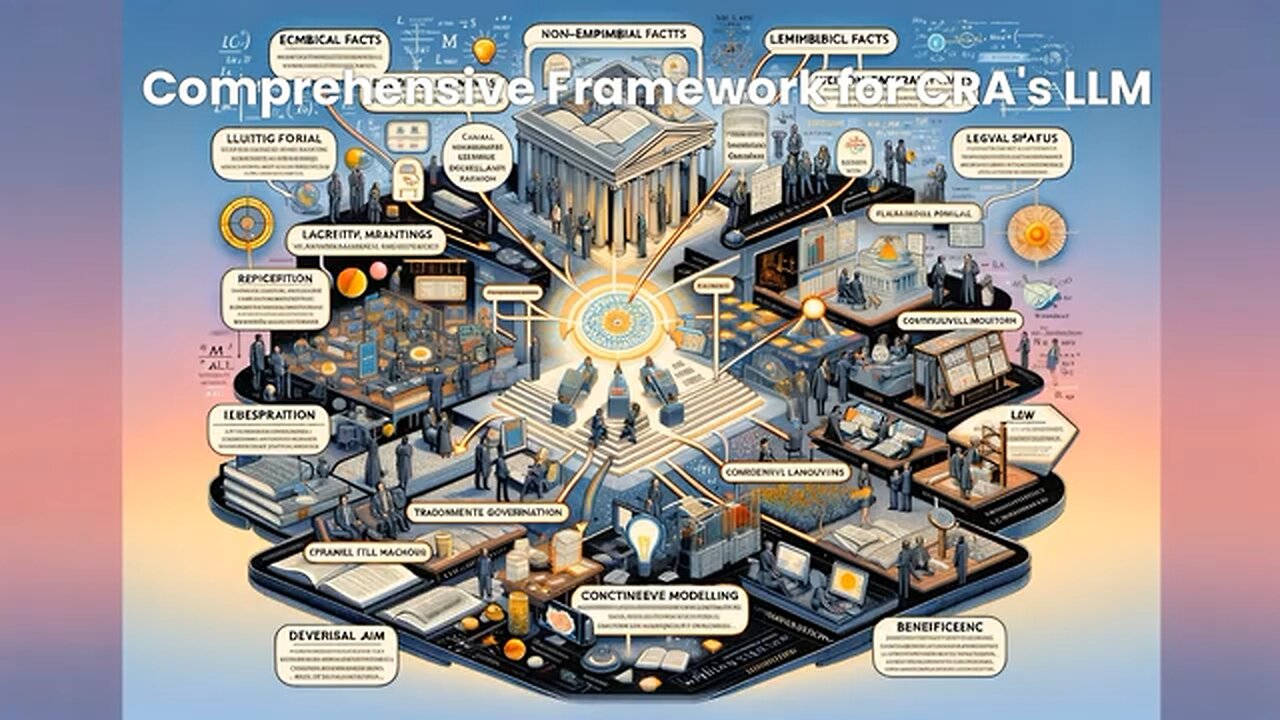Premium Only Content

Comprehensive Framework for CRA's LLM
1. Open Source Framework:
- Public Data: All empirical and non-empirical facts, and formulas are publicly accessible for review through the portal.
2. Empirical Facts:
- Primary Data Source: Empirical data prioritized for decision-making.
3. Non-Empirical Facts:
- Weighted Probabilities: Non-empirical data assigned probable weights based on reliability.
4. Scientific Equations:
- Open for Review: All formulas are open and continuously refined by GAI as new data emerges.
5. Model Deduction by GAI:
- Dynamic Models: GAI deduces all models and continuously updates them based on new facts and bad results.
6. Comprehensive Human Language Analysis:
- All Human Writings: GAI uses all types of human writings, including legal, poetic, and more, to gather information and understand human contexts.
7. Diverse Sources of Information:
- Fields of Study: Include data from various arts and sciences.
8. GAI Modeling and Education:
- Continuous Modeling: GAI models all arts and sciences continuously.
- Personal Assistants: Personal assistants in the portal use these models to inform, teach, and provide certified education certificates.
9. GAI Logic and Continuous Updating:
- Dynamic Logic Creation: GAI creates its own logic from all available data, continuously updating it as new facts emerge.
- High Weight on Veracity: Highly weights all inputs for veracity and accuracy.
10. Isolation for Safety:
- Isolation AI for Inputs: Protecting GAI by ensuring all inputs come through the isolation AI to CRB's portal, preventing harmful or manipulative data.
- Isolation AI for Outputs: Protecting reality by ensuring all outputs go through the isolation AI in the CRB's portal before release, ensuring information is safe and accurate.
11. Continuous Monitoring and Improvement:
- Continuous Monitoring: GAI will monitor all data sources continuously to make necessary adjustments and improvements to the system.
12. Legal and Ethical Compliance:
- Independent Governance: The CRB, as an independent branch created by the CRA, is not subject to external legal requirements outside of the constitutional amendment that established it.
- Constitutional Adherence: Ensure the LLM and all operations comply strictly with the guidelines and mandates set forth by the CRA.
Ethical AI Guidelines for CRA's LLM:
- Integrity: Ensure all data and processes are honest and transparent.
- Fairness: Treat all inputs and users without bias.
- Accountability: Clearly define responsibility for the AI's actions and outcomes.
- Respect: Consider the rights and privacy of all individuals involved.
- Transparency: Provide clear documentation and explanation of AI processes and decisions.
- Beneficence: Use AI to promote the public good and enhance societal well-being.
- Non-Maleficence: Design the LLM to avoid causing harm and ensure safety.
Summary:
- Transparency: All open-source data, including empirical and non-empirical facts, and scientific formulas, are available through the CRB portal.
User Education and Training:
Comprehensive Education:
- Provide education programs covering all subjects from kindergarten through PhD levels.
Hands-On Learning:
- Facilitate hands-on learning experiences through partnerships with educational institutions and organizations.
Data Security and Privacy:
Robust Security Measures:
- Implement advanced security protocols to protect the integrity of data and ensure user privacy.
- High Crime Penalty: Per CRA, any tampering from within and externally is considered a high crime punishable by 20 years to life for each offense.
Privacy Compliance:
- Ensure all data handling practices comply with privacy standards and ethical guidelines to protect user information.
This document provides a comprehensive overview of the CRA's LLM framework, ensuring transparency, security, and ethical compliance while empowering citizens with accurate and reliable information.
-
 5:59:05
5:59:05
SpartakusLIVE
10 hours ago#1 MACHINE Never Stops The GRIND || LAST Stream UNTIL Friday
152K2 -
 28:36
28:36
Afshin Rattansi's Going Underground
1 day agoDoug Bandow: ENORMOUS DAMAGE Done to US’ Reputation Over Gaza, Trump ‘Easily Manipulated’ by Israel
33.4K31 -
 2:45:13
2:45:13
Barry Cunningham
17 hours agoCBS CAUGHT AGAIN! CHICAGO A MESS! LISA COOK IS COOKED AND MORE LABOR DAY NEWS!
122K51 -
 6:39:17
6:39:17
StevieTLIVE
11 hours agoMASSIVE Warzone Wins on Labor Day w/ Spartakus
37.9K1 -
 10:46:42
10:46:42
Rallied
17 hours ago $18.70 earnedWarzone Challenges w/ Doc & Bob
204K4 -
 3:26:25
3:26:25
Joe Donuts Live
10 hours ago🟢 Lost in Space with My Clones: The Alters Adventure Begins
40.2K5 -
 7:20:22
7:20:22
Dr Disrespect
18 hours ago🔴LIVE - DR DISRESPECT - TRIPLE THREAT CHALLENGE - WINNING AT EVERYTHING
227K12 -
 2:35:33
2:35:33
Chrono
11 hours agoBirthday-eve Stream | Helldivers II
33.3K1 -
 54:40
54:40
BonginoReport
1 day agoLABOR DAY SPECIAL! The Best of Nightly Scroll - Nightly Scroll w/ Hayley Caronia (Ep.124)
140K16 -
 2:39:21
2:39:21
Joker Effect
9 hours agoReviewing the downfall of Kick Streaming. Kick streamers welcome to Rumble! Stake bombshell found!
40.3K1